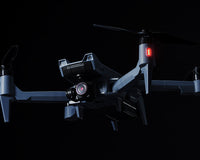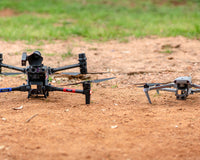If you're looking for an affordable drone that can adequately handle enterprise-level missions, you need to consider DJI's all-new Mavic 3 Enterprise Series.
Unveiled on Sept. 27, these additions to DJI's Enterprise lineup are available in two models:
- Mavic 3 Enterprise (M3E) and
- Mavic 3 Thermal (M3T).
Besides their affordable price points, these small commercial drones come stacked with impressive features.
So, which of these two DJI Enterprise drones do you need?
Let's break them down.

DJI Mavic 3 Enterprise Series
As mentioned, this series comes in two different models with fairly similar features. The M3E and the M3T are all-in-one platforms that exemplify operational efficiency, portability, and ease of use.
The Mavic 3 Enterprise is an updated version of the Mavic 3 or the Mavic 3 Cine. Conversely, the M3T is much more similar to the M2EA.
The main difference is that the M3T has thermal capabilities, which the M3E lacks. Additionally, the M3E has a mechanical shutter, which is a major feature if you're mapping and surveying, as Phantom 4 RTK users know well.
This, of course, means they are meant for different use-cases.
For instance, the M3E is better placed when conducting daytime inspections, surveys, and mapping. Contrarily, the M3T does exceptionally well during search-and-rescue, emergency response, and nighttime inspections.
Here is a detailed video of the two models: DJI Mavic 3 Enterprise: Unboxing & First Look.
Analyzing your organization's budget, mission requirements, and other pain-points greatly contributes to a worthwhile UAV purchase. A worthy investment is the surest way to your drone program's sustainability. It also ensures you reap maximum benefits.
Related Article: How to Create a Law Enforcement Drone Program in 8 Steps
So, what separates the M3E series from other drones in the industry?
Design
If portability tops your "needs" list, you'll love Mavic 3 Enterprise.
Mavic-series drones are small, lightweight, and foldable - the M3E and M3T are no exception. The M3E weighs only two pounds, and the M3T is only a few ounces heavier.
They're portable enough to hold in your hand and pack away in a backpack which, for an enterprise drone, is refreshingly convenient.
Aside from that portability, you'll have M3E ready to fly in seconds. And, you'll have accessories, such as the RTK module and speaker system, mounted just as quickly.
In fact, the M3E and M3T can accommodate many accessories, including:
- The aforementioned speaker system with audio storage that has text-to-speech and supports looping;
- an RTK module to enhance centimeter-level accuracy during surveying and mapping operations; and
- A D-RTK 2 Mobile Station that houses all significant global satellite navigation systems, facilitating real-time differential modifications.
The speaker will greatly improve your operational efficiency during search and rescue operations; the RTK module will ramp up your output's accuracy levels during mapping and surveying missions; and the mobile GNSS receiver does away with the need for Ground Control Points, thus allowing you to survey with increased speeds.
However, these accessories aren't included in the standard package - you'll need to purchase them separately.
These drones also feature an improved propeller design that significantly minimizes flight noise.
Both would be perfect for patrols and surveillance operations, allowing you to tail your suspects while maintaining your cover.
So, what about their camera systems?
Camera performance
The M3E and M3T both come equipped with impressive imaging capabilities for their size - each having a camera designed for specific use-cases. They also incorporate numerous visual sensors into a single payload.
Let's start with the differences.
M3E features a wide-angle camera with a 4/3-inch CMOS and a 20-effective-MP sensor with an 84° field of view (FOV). That camera offers a coveted feature that hasn't yet been available on a Mavic series drone - the mechanical shutter, which provides substantial data in every image. Additionally, it prevents motion blur and supports shorter shooting intervals of 0.7 seconds.

It does also come with an electronic shutter option, which is on straight out of the box. So, if you want to use that mechanical shutter, make sure to switch it on prior to take-off.
While M3E lacks a thermal camera, its intelligent low-light mode, coupled with 3.3μm pixels on its wide camera, enhances visibility under poorly lit conditions.
The M3T model includes a wide camera with a 1/2-inch CMOS and a 48-effective-MP sensor with an 84° FOV.
Its 12 μm pixel thermal sensor features a 61° Display Field of View (DFOV) and an equivalent focal length of 40mm, with 640×512 px resolution.

It also has a 28x digital zoom, and a split screen feature for easier comparisons during your missions.
Additionally, the thermal camera has robust features that allow high-heat signature alerts, spot-area temperature measurement, and ten color palettes to choose from for effective decision-making during your surveillance operations.
The M3T might be the small, yet agile drone that your department needs, if you need portability with your thermal sensor.

*Top view at 1.3x zoom; bottom view at 56x zoom
As for similar features, both drones come equipped with a 1/2-inch CMOS tele camera that provides incredible zooming capabilities. The 12-effective-MP sensor, complete with a 15° FOV and an equivalent focal length of 162 mm, supports a 56x maximum hybrid zoom.
Both drones also record 4K or full HD videos at 30fps.
The Mavic 3 Enterprise Series camera features make them fit for almost any use case you can imagine.
So, what about battery life? Let's cover it.
Battery performance
As a remote pilot, one of the biggest drawbacks to a great UAS is less-than-optimal battery life. The amount of battery life you have could make the difference between capturing a suspect or covering a whole job site on time.
The M3E is portable and has a great camera, but how long does it stay in flight?
The advertised maximum airtime under ideal conditions is 45 minutes, with a hover time of about 39 minutes per LiPo 4S battery with a 5000 mAh capacity. Obviously, your payload and suboptimal weather conditions dampen that. But, you'll get a solid 35-plus minutes under most circumstances.
The LiPo 4S battery takes about 70 minutes to move from zero to 100 percent, whereas you'll only need about 50 minutes to boost it from zero to ninety percent. Additionally, the drone series has an optional fast-charging hub with an output power of 100W, which can charge three batteries in succession.
If you need to stay in the sky for long stretches, then M3E and M3T will keep you in flight.
But, how safe are they?

Safety features
Most remote pilots can relate to that unsettling feeling you get while flying in potentially dangerous spaces, such as canopied areas or around skyscrapers.
With DJI's M3E and M3T, you'll no longer have to endure that anxious feeling, as they incorporate some pretty impressive safety features.
For starters, the they both use a superior collision avoidance system.
With wide-angle lenses on all sides, you'll be able to modify proximity alerts. And, with APAS 5.0 technology, the drones will automatically reroute from a path with obstacles.
Another impressive feature is the ability to resist winds up to 27 MPH. These drones do astoundingly well for their size against windy conditions, which hasn't always been a hallmark of Mavic drones.
You'll also get DJI AirSense, which uses ADS-B signals to detect crewed aircraft around your airspace.
You can bet on wind tolerance, omnidirectional sensing, and air traffic alerts to fly with peace of mind.
Besides safe flying, these portable commercial drones also include an array of smart features.
Smart features
The Mavic 3 Enterprise series drones have pre-flight checklists that help you to ensure your drone is at optimum health for your mission requirements.
You get to save time and power by using the RTH feature, which automatically reroutes your drone from its flight path to where it took off.
So, what about the transmission capabilities?

Transmission reliability
A drone is as good as its transmission capabilities.
So, how good are the Mavic 3 Enterprise series drones in terms of image transmission while flying across rugged terrain?
Well, they use the DJI O3 Enterprise Transmission, which is more advanced than Occusync, and better for navigating complex environments. As a result, you'll have a high live-view quality at 1080p/30fps, viewable through your RC Pro Enterprise controller, which is included in the standard package.
That controller, which provides touch-screen capability, features a built-in microphone, a 1,000-nit high-brightness screen for enhanced daytime visibility, and fast-charging capability, which minimizes downtime.

Software Ecosystem
The Mavic 3 Enterprise Series drones have a pretty robust software ecosystem.
Each positively influences your operations as follows:
DJI Pilot 2 - features a user-friendly interface for easier access to drone and payload controls, flight, and navigation details. Thus, overall enhancing your piloting efficiency.
DJI FlightHub 2 - a cloud operations management software that adequately manages flight operations, such as UAV route planning.
DJI Terra - a mapping software that is particularly handy when generating 2D and 3D models.
DJI Thermal Analysis Tool 3.0 - a software tool used to analyze, annotate, and process M3T to detect temperature abnormalities.
PSDK, MSDK, and Cloud API are the approved open-source interfaces that allow the Mavic 3 Enterprise Series drones to interact with third-party platforms.
If you're worried about user-data security, we discuss how DJI tackled this in the next section.
Cybersecurity features
DJI has integrated advanced technology to safeguard all your stills, videos, flight logs, and other data generated during sensitive flights. Cybersecurity is a common non-negotiable across all industries.
The drones have user security features, such as local data mode, which limits DJI Pilot 2's interaction with data over the internet. The airframes are also equipped with AES-256 video transmission encryption and a Cloud API.
If worst comes to worst, DJI also included a One-Tap Clear All Device Data feature to enable you to take control of the situation.
A cyber-secure UAS is a valuable addition to any department’s drone program, especially with cyber crimes on a steady rise.
Drawbacks
The Mavic 3 Enterprise Series drones can tackle nearly any mission, but they're not perfect.
For starters, unlike the Mavic 3 Cine drone which includes 1 TB of build-in storage, they lack internal storage, so you'll need to carry extra SD cards around for your missions.
And, this is a big one if you've seen the DJI M30 and wondered about this feature, they are only suitable to be flown under fair weather conditions since they are not weatherproof. Thus, the M30 might be your best bet if your department needs a relatively portable weatherproof platform.
Related Article: Is the DJI Matrice 30 Series the Right Drone for You?

Should You Invest in the Mavic 3 Enterprise Series Drones?
DJI continues pushing the boundaries by innovating all-in-one platforms at affordable price points.
The Mavic 3 Enterprise Series drones are a prime example of such. These drones ensure your department can access all of these new technologies without breaking the bank.
If you need a portable mapping drone with outstanding zoom and a mechanical shutter, M3E is perfect. Need mostly all of that with the inclusion of thermography? M3T is the way to go, especially for public safety.
If you're still not sure about whether or not to invest in one of these platforms, we're here to help. At Advexure, we work with remote pilots just like you who need to make the right investment for their specific uses.
From planning missions and building a program to actually purchasing your drone, we've got you covered. To get started, just open up the chatbox on the side of your screen and connect with one of our UAS experts. Also, make sure to ask if you qualify for our loaner leasing program, where you can try the drone before you buy it.
Note: This program is strictly for enterprise customers.










